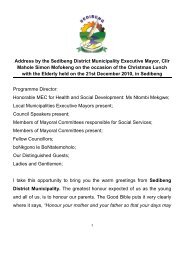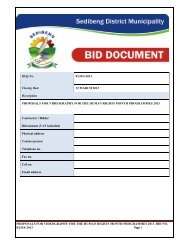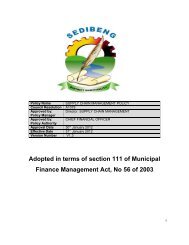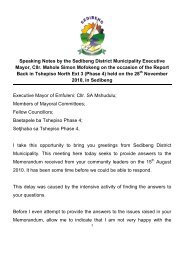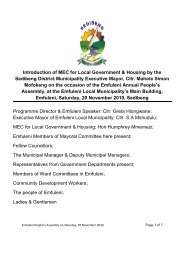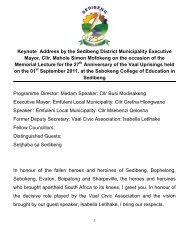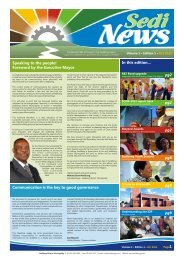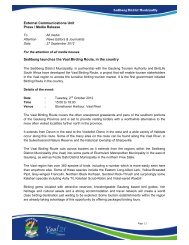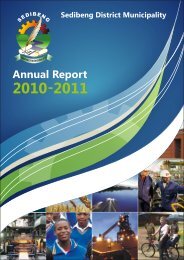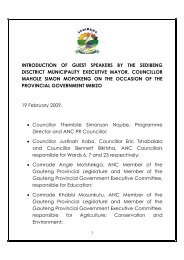Chapter 11 - Sedibeng District Municipality
Chapter 11 - Sedibeng District Municipality
Chapter 11 - Sedibeng District Municipality
Create successful ePaper yourself
Turn your PDF publications into a flip-book with our unique Google optimized e-Paper software.
2 LEGISLATIVE FRAMEWORK FOR TRANSPORT<br />
This chapter describes the implications of national and provincial policy and<br />
legislative framew ork of relevance to the SDM from a transportation point of view .<br />
This chapter concludes w ith a discussion about the role of municipalities in terms of<br />
the National Land Transport Act, 2009 (Act 5 of 2009).<br />
2.1 National Policy and Legislation<br />
(a) White Paper on National Transport Policy, 1996<br />
The DoT published a White Paper on National Transport Policy in 1996 w hich states<br />
the vision for transport in South Africa as follow s:<br />
“Provide safe, reliable, effective, efficient, and fully integrated transport operations<br />
and infrastructure which will best meet the needs of freight and passenger customers<br />
at improving levels of service and cost in a fashion which supports government<br />
strategies for economic and social development whilst being environmentally and<br />
economically sustainable”.<br />
The six broad goals as outlined in the White Paper are:<br />
• to support the goals of the Reconstruction and Development Programme<br />
(RDP) in meeting basic needs, grow ing the economy, developing human<br />
resources, and democratising decision making;<br />
• to enable customers requiring transport for people or goods to access the<br />
transport system in w ays which best satisfy their chosen criteria;<br />
• to improve the safety, security, reliability, quality and speed of transporting<br />
goods and people;<br />
• to improve South Africa’s competitiveness and that of its transport<br />
infrastructure and operations through greater effectiveness and efficiency to<br />
better meet the needs of different customer groups, both locally and globally;<br />
• to invest in infrastructure or transport systems in w ays which satisfy social,<br />
economic or strategic investment criteria; and<br />
• to achieve the above objectives in a manner w hich is economically and<br />
environmentally sustainable, and minimises negative side effects.<br />
(b) Moving South Africa, the Action Agenda, 1990<br />
The vision for transport in 2020 as formulated in the Moving South Africa project,<br />
commissioned by NDoT and completed in the late 1990s, is as follows:<br />
“By 2020, transport in South Africa will meet the needs of freight and passenger<br />
customers for accessible, affordable, safe, frequent, high quality, reliable, efficient<br />
and seamless transport operations and infrastructure. It will do so in a constantly<br />
upgrading, innovative, flexible and economically and environmentally sustainable<br />
manner. In so doing, transport will support and enable government strategies,<br />
particularly those for growth, development, redistribution, employment creation and<br />
social integration, both in South Africa and in the Southern African region”.<br />
The strategy is to consolidate core transport assets into high volume corridor strategic<br />
netw orks and dense development nodes, assisted by a supporting netw ork, in areas<br />
SDM DITP, 2008 to 2013 <strong>11</strong> 31 Aug 2010



